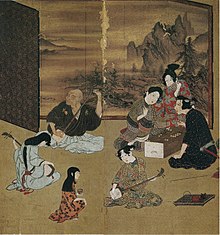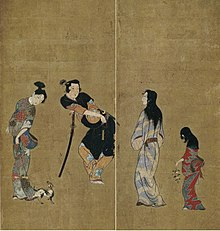Hikone screen
The Hikone screen ( Japanese 彦 根 屏風 Hikone byōbu ) is a six-part Japanese screen with unknown origins from the Kan'ei period (approx. 1624–44). It was long owned by the Ii clan who resided at Hikone Castle. Today the screen can be seen in the Hikone Castle Museum. It is registered as a national treasure.
description
The screen, an example of the Momoyama genre painting , consists of six panels with a total size of 94.5 × 278.8 cm. A total of 15 people can be seen on a gilded background made of paper, depicting scenes from an entertainment district, probably in Kyoto .
- The first shows a group of people, an old blind shamisen player who includes two other shamisen players and a girl listening with a teacup.
- On the second screen on the right, two women and a man are sitting at a Sugoroku game. These two groups sit in front of a screen on which a landscape, painted in the style of the Kanō school , can be seen.
- The third screen on the right shows two reading men and a writing woman.
- The fourth screen only shows a little girl with a pointing gesture.
- The fifth screen shows a woman turning to a samurai .
- The sixth screen shows a woman and a girl both turning left. The figures on the 5th and 6th panels could represent the clothes (from the right) spring, summer, autumn and winter.
The people on the left deal with the “Four Chinese Arts” ( Chinese 琴棋 書畫 , Pinyin Qín qí shū huà ), that is, with Koto and Go games , with calligraphy and painting . Here, as a parody, the first two arts are represented by the shamisen, an instrument that was played in taverns, and sugoroku, which was also a game of the lower classes.
If you look at the entire screen, only the first two panels on the left - with a classic screen in the background - form an inseparable unit. The other groups of figures are held together by the continuous gold background. There are small, picturesque transitions between the second and third and between the fifth and sixth panels, but they may have been added later. With the picturesque focus on the left, the screen could be the left of a pair of screens.
In 1955 the Hikone screen was declared a national treasure under the name “Genre painting on a gilded paper background ” ( 紙 本金 地 著色 風俗 図Shihon Kinjichaku-shoku Fuzoku-zu ).
More screens with this topic
There is a six-part screen by an unknown artist that is privately owned. It shows a similar scene on a gold background, i.e. a group of musicians on two panels on the left in front of an adjustable screen, other people on the other four panels, some of whom are standing and others are sitting at a low table.
The Hikone screen itself later became the template for replicas in excerpts and modifications, such as by Hanekawa Chinchō ( 羽 川 珍重 ; 1679–1794), Takebe Sōchō ( 建 部 巣 兆 ; 1761–1816. See the Bälz collection ) and for a complete copy by Mitani Arinobu ( 三 谷 有 信 ).
literature
- Hikone byobu . In: Nihon no Bi o meguru No 46 . Shogakukan, 2003.
- Hikone Castle Museum (Ed.): Hikone byobu zo Yuraku no Sekai . 1990.
- Hibi Tami (Ed.): Hikone-jo .




